What is Bootsect.exe and How to Use It
The bootsect.exe utility is used to update the partition bootsector code responsible for loading and running the bootloader. Depending on the circumstances, the utility can also be used to update the master boot record code of a hard disk partition without editing the partition table. The Bootsect.exe utility is available in Windows XP, Vista, 7, 8, 8.1 and 10.
This utility is mostly used when the volume boot code (residing on the Windows drive) has become corrupt or was accidentally programmed to make use of the wrong boot manager. This will trigger a whole array of system-halting errors known as hal.dll errors in Windows Vista, 7, 8, and 10.

Note: Bootsect.exe is also used to Boot Configuration Data File is Missing error or to create a bootable USB drive.
Luckily, the bootsect.exe utility is very efficient when it comes to correcting volume boot code errors. However, this boot sector restore tool is only available via Command Prompt – accessible from Advanced Startup Options or System Recovery Options (depending on your Windows version).
Below you have a collection of step by step guides on accessing the Bootsect utility. Keep in mind that the exact steps of running bootsect.exe will be different, depending on your Windows version. Please follow the guide appropriate to your Windows version.
How to Use the Bootsect Utility on Windows 7
There are two different ways of accessing Bootsect on Windows 7. The ideal way would be to use an installation media. However, if your computer has the System Recovery Options pre-installed, you might be able to run the Bootsect utility without the installation media.
If you have your Windows installation media, follow the guide directly below (Method 1) to run bootsect.exe. In the event that you don’t have the installation media, follow the second guide (Method 2) to access the Bootsect utility.
Method 1: Accessing Bootsect using the installation media on Windows 7
- Insert your Windows media disk or bootable flash drive to boot from it. If your system doesn’t automatically boot from the newly inserted media, you might need to access your BIOS/UEFI settings and change the boot sequence order.
- At the first Install Windows screen hit Next, then click on Repair your computer. You can also press the R key for the same result.
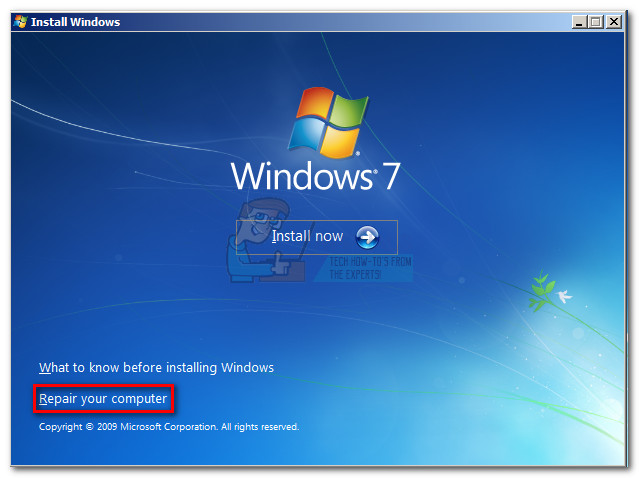
- Select Use recovery tools that can help you fix problems starting Windows. Then, make sure Windows 7 is selected and hit Next.
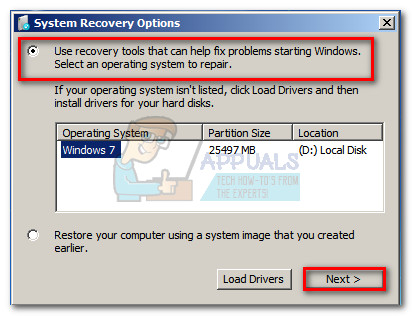 Note: You’ll only see two entries under Operating System if you dual boot your computer.
Note: You’ll only see two entries under Operating System if you dual boot your computer. - In the System Recovery Options, click on Command Prompt.

- Type the following command into Command prompt and press Enter to run the Bootsect utility:
bootsect /nt60 sys
 Note: The bootsect /nt60 sys command is used for the newer BOOTMGR present on Windows Vista, 7, 8 and 10. For older Windows version, the bootsect /nt52 sys command is used instead.
Note: The bootsect /nt60 sys command is used for the newer BOOTMGR present on Windows Vista, 7, 8 and 10. For older Windows version, the bootsect /nt52 sys command is used instead. - If you see the message “Bootcode was successfully updated on all targeted volumes”, the volume boot code used by BOOTMGR should now be updated.
Note: If you receive an error after inserting the command, try running bootsect /nt60 all. This command will solve most permission related issues. But keep in mind that if you have a dual-boot setup, the other OS will also be affected. - Close Command Prompt and remove the installation media. Then, click the Restart button from the System Recovery Options. After the restart, Windows should boot normally.
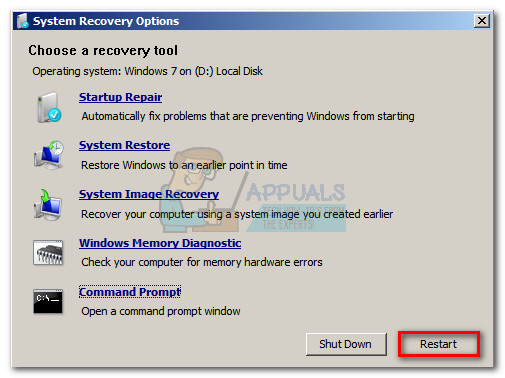
Method 2: Accessing Bootsect without the installation media on Windows 7
If you don’t have the Windows installation media, you have a couple of ways forward. You can either create a Windows installation media and follow the guide above or access the pre-installed recovery tools on the hard disk.
In the event that you decide to create your own installation media, you can follow our complete guide to creating a Windows 7 bootable DVD or USB drive. Then, backtrack to the guide directly above and use it to run the Bootsect utility.
Else, follow the steps below to access the pre-installed recovery tools. But keep in mind that not all computers come with recovery tools pre-installed. If the steps below don’t work, you have little choice but to create a Windows installation media.
- Start/restart your computer. As soon as your computer boots up press the F8 key repeatedly to open the Advanced Boot Options.
- In Advanced Boot Options, use your arrow keys to highlight Repair Your Computer and hit Enter.
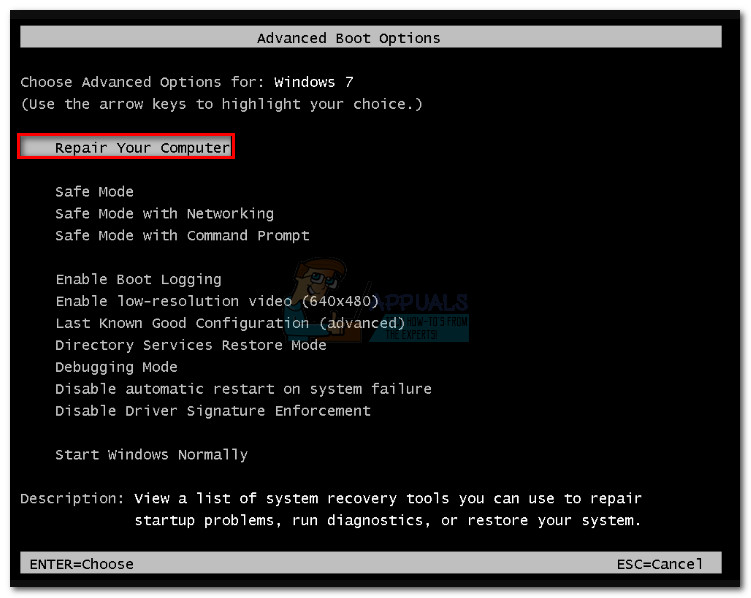
- The System Recovery Options should pop-up shortly. Select Command Prompt from the list.

- Type the following command into Command prompt and press Enter to run the Bootsect utility:
bootsect /nt60 sys
 Note: The bootsect /nt60 sys command is used for the newer BOOTMGR present on Windows Vista, 7, 8 and 10. For older Windows version, the bootsect /nt52 sys command is used instead.
Note: The bootsect /nt60 sys command is used for the newer BOOTMGR present on Windows Vista, 7, 8 and 10. For older Windows version, the bootsect /nt52 sys command is used instead. - If you see the message “Bootcode was successfully updated on all targeted volumes”, the volume boot code used by BOOTMGR should now be updated.
Note: If you receive an error after inserting the command, try running bootsect /nt60 all. This is known to solve several permission related issues. But keep in mind that if you have a dual-boot setup, the other OS will also be affected. - Close Command Prompt and click the Restart button from the System Recovery Options. After the restart, Windows should boot normally.

How to Use the Bootsect Utility on Windows 8.1 and 10
Similar to the procedure on Windows 7, you can run the Bootsect utility in several different ways on Windows 8 and Windows 10. The easiest method will be to use the Windows installation media. However, there are several different other methods that you can use to access the bootsect.exe utility if you don’t have the installation media.
If you own a Windows 10 installation media, follow Method 3 to run the bootsect utility. In the event that you can’t use the installation media, follow Method 4 to explore different possibilities of running bootsect.exe.
Method 3: Running Bootsect using the installation media on Windows 8.1 and 10
- Insert the installation media and make sure your computer boots from it.
Note: If you’re unable to boot from the installation DVD/USB, access your BIOS/UEFI settings and change the boot sequence. - In the Windows Setup screen, click Next, then click on Repair your computer.
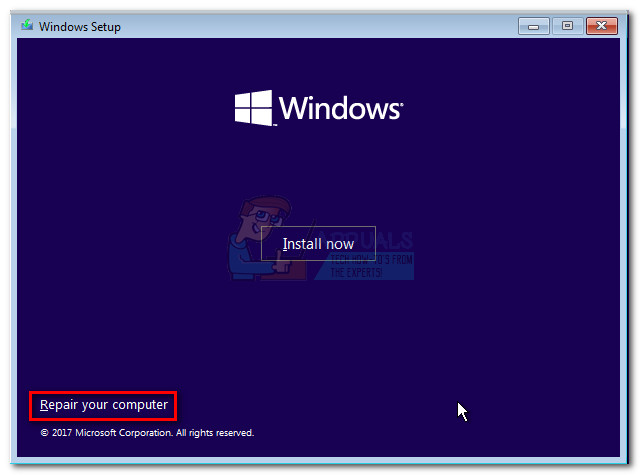
- At the following screen, click on Troubleshoot to access the Advanced options.

- Under Advanced options, click on Command Prompt.

- Type the following command into Command prompt and press Enter to run the Bootsect utility:
bootsect /nt60 sys
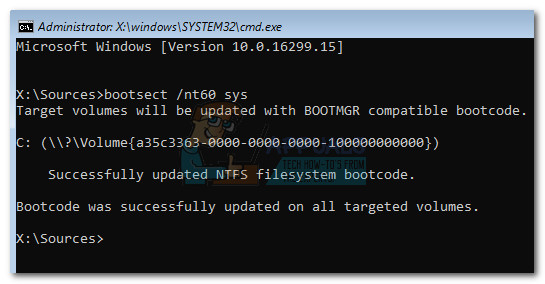 Note: If you encounter an error after hitting Enter, try running the bootsect /nt60 all. But keep in mind that this will also update the boot code from the other OS if you have a dual boot setup.
Note: If you encounter an error after hitting Enter, try running the bootsect /nt60 all. But keep in mind that this will also update the boot code from the other OS if you have a dual boot setup. - If you see the message “Bootcode was successfully updated on all targeted volumes”, you can safely close Command Prompt, remove the installation media and click on Turn off your PC. The volume boot code is now updated.

Method 4: Running Bootsect without the installation media on Windows 8.1 and 10
If you don’t have the installation media for Windows 8 or Windows 10, you can make use of several workarounds to gain access to the Advanced Startup menu and run the bootsect.exe utility:
- Follow this guide (here) to create a bootable USB drive for Windows 10 with Rufus, then follow Method 3.
- Force two (or three) consecutive failed attempts to start Windows. You can do this by shutting down your machine while it’s in the middle of booting up. This is by no means elegant, but it will force Windows to automatically start the Advanced Startup menu when booting up.
- If your computer is able to boot up successfully, you can force Windows 8 or Windows 10 to automatically restart into Advanced Startup. To do this, open a Run window (Windows key + R), type “ms-settings:” and hit Enter. In the Settings menu, select the Recovery tab, scroll down to Advanced Startup and click on Restart now.

If you followed one of the instructions above, you should find yourself in the Advanced Startup menu. Once there, follow the instructions below:
- Click on Troubleshoot to access the Advanced options.

- Under Advanced options, click on Command Prompt.

- Type the following command into Command prompt and press Enter to run the Bootsect utility:
bootsect /nt60 sys
 Note: If you encounter an error after hitting Enter, try running the bootsect /nt60 all. But keep in mind that this will also update the boot code from the other OS if you have a dual boot setup.
Note: If you encounter an error after hitting Enter, try running the bootsect /nt60 all. But keep in mind that this will also update the boot code from the other OS if you have a dual boot setup. - If you see the message “Bootcode was successfully updated on all targeted volumes”, you can safely close Command Prompt and click on Turn off your PC. The volume boot code is now updated.
